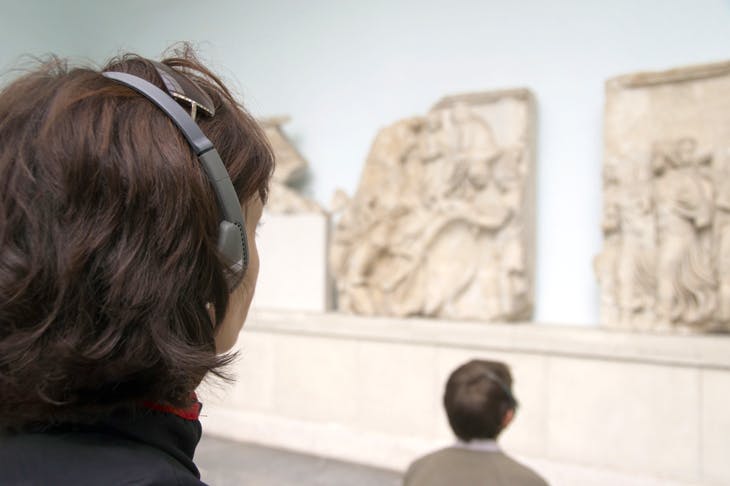Do you, or do you not, fork out for an audioguide — one of those necklace-like, strappy contraptions you’re offered at the beginning of exhibitions, which cost an extra £3.50?
The nation is divided. Some loathe them — as I was reminded reading an obituary of the historian Eric Christiansen, which said, ‘The British Museum’s Viking Exhibition in 2014 drew his wrath as visitors blocked everyone else’s view as they listened to their headsets, while ignoring any object which did not have a spoken description.’
I blushed, because that’s exactly what I do. Not in room one or two, when I’m still all energy and excitement and take pains to look at every single item with equal attention. But by about room five, when I discover that there are still seven more rooms to go, I start giving scant attention to items that don’t have a headset sign and full rapturous attention only to items that do. I notice that even people without audioguides tend to cluster round any ‘headset’ item, because the headset sign denotes importance. I feel sorry for the second-class items either side of it that don’t have a headset sign, but life’s too short, and the exhibition’s too long, to worry.
I love audioguides: indeed, I have come to depend on them. At their best, they make the exhibition-going experience feel as if you’re actually in a documentary written and narrated by a wonderful amalgam of all your favourite art-historian presenters. They alleviate the long, lonely silence of exhibitions. I love the music of the period they play to you in room one, to get you in the mood. It really works. Without the help of the co-curator’s voice in my ear, I would simply never have noticed (to give an example from the current Russian revolution exhibition at the RA) ‘the way the samovar reflects the vessels on the table’ or have known that ‘those Soviet banners were probably painted by icon-painters’. I pity the audioguideless people around me who aren’t hearing these fascinating insights. Audioguides are proof that we have not ‘had enough of experts’. When a narrator says, after a long spiel, ‘Press “33” if you’d like to hear more about the design of cuffs in the 1650s,’ I’m strongly tempted. Even if I don’t go quite as far as pressing ‘33’, I like knowing there’s a bank of additional knowledge I could tap into if I wanted to.
What’s more, with an audioguide, you’re spared having to read the writing on the wall. I’ve never been good at reading the writing on the wall, metaphorically or literally. I find it a terrible strain on the eye and the brain, gazing up there, confronting my ignorance and bewilderment and trying to force my eye down to the beginning of the next line of abstract nouns and ‘-isms’. With an audioguide, the person explains it all to you instead, so it’s like listening to a good episode of In Our Time.
But audioguide life is not all plain sailing. For a start, the volume is either non-existent or deafening when you first put the thing on. Then, all too often, having just listened to item 14, you find yourself at item 16 and realise you must have missed one out. So are you going the wrong way round the room? Where the hell is 15? Then, you need to take your coat off halfway round, which is virtually impossible because all the straps and headphone wires have got tangled with your own various necklaces and straps.
But worse, wearing an audioguide makes the act of exhibition-going an antisocial one — unless, that is, you and your companion say ‘One, two, three, go!’ at each headphone item so you’re at least listening to the commentary together. Even that is not exactly chatty. At the RA exhibition this week I bumped into two friends who were having a lovely time there, without audioguides, and I envied their freedom to chat and laugh and notice whatever they liked together. My youngest son flatly refuses to wear one, as he says it’s far too much like being at school with people telling you things all the time. He would much prefer to use his own eye and notice what he likes — and it’s true: audioguides can be limiting as well as broadening if we become too dependent on them. Maybe that smallish painting of a tractor workshop (without headset sign) is actually a masterpiece. Just because some curator has decided it isn’t worthy of a headset sign doesn’t mean it should be consigned to the second-class dustbin of art history.
We need those experts — but the experts themselves would never dream of wearing an audioguide. They know enough already. It would not be done to be seen wearing one at a private view where you might bump into Philip Mould. That would be embarrassing. By choosing to wear one, I’m advertising the fact that I don’t know much and need tuition. It is, perhaps, as uncool as going round a city clutching a tourist map. But on balance, I think, enhancing enough to be worth it.
Got something to add? Join the discussion and comment below.
Get 10 issues for just $10
Subscribe to The Spectator Australia today for the next 10 magazine issues, plus full online access, for just $10.
You might disagree with half of it, but you’ll enjoy reading all of it. Try your first month for free, then just $2 a week for the remainder of your first year.














Comments
Don't miss out
Join the conversation with other Spectator Australia readers. Subscribe to leave a comment.
SUBSCRIBEAlready a subscriber? Log in